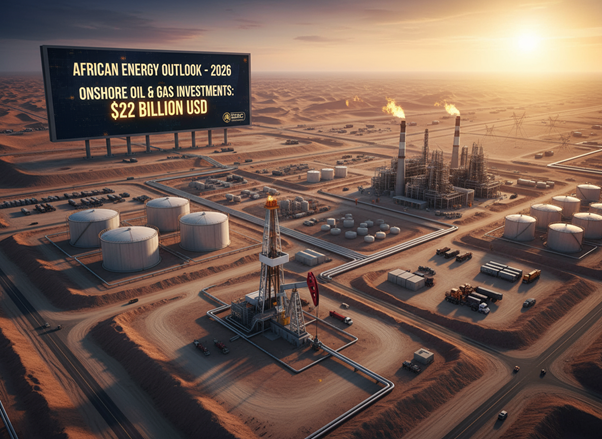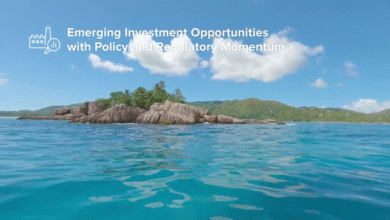Onshore : $22 billion in investments expected in 2026, balancing stability and expansion
According to the African Energy Chamber (AEC) outlook, investments in the African onshore oil and gas sector are expected to reach $22 billion in 2026, while production should remain stable thanks to the optimization of mature fields and new exploration campaigns in Angola, Zimbabwe, and Namibia.

The African oil and gas landscape is experiencing notable shifts, with a renewed focus on onshore fields. While offshore projects continue to expand, onshore operations remain critical for the continent’s hydrocarbon supply, particularly in Algeria, Libya, and Nigeria. Onshore production thus continues to serve as a strategic pillar for local economies and regional energy security.
Onshore production remains a strategic pillar for local economies and regional energy security
In Algeria, total hydrocarbon production is expected to remain stable at around 3 million barrels of oil equivalent per day over the next five years, with a target of reaching 200 billion cubic meters of gas per year, including 100 billion for export. Ongoing projects such as Tin Fouye Tabankort Sud and In Amenas II, scheduled to start in 2026, will help stabilize onshore oil and gas production at approximately 1 million barrels per day and 10 billion cubic meters per year, respectively.
Libya is also pursuing a diversified strategy to increase onshore production. With 93% of its oil and gas produced onshore, the country aims to reach 2 million barrels per day, supported by a licensing cycle for 22 onshore blocks in 2025, 11 of which are available for exploration. The Libyan government is prioritizing the rehabilitation of existing fields such as Sarir, Mesla, Amal, Ghani, and Waha, as well as the development of newly discovered sites to maximize reserve replacement rates.
In Nigeria, onshore production increased in 2024 due to improved security measures and the growth of local players. The country aims for 2.1 million barrels per day by the end of 2025 and 3 million by 2030. This plan is supported by projects such as TotalEnergies’ Ubeta gas development and the ANOH project led by Seplat and Renaissance. NJ Ayuk, Executive Chairman of the AEC, emphasizes that “the emergence of new onshore players signals a promising future for Africa’s onshore landscape. While the majority of major company investments have shifted offshore, the rise of local actors will allow onshore production to remain stable, and even increase, in the coming years.”
Emerging markets also show strong potential
Emerging markets are also showing significant potential. In Zimbabwe, exploration by Invictus Energy on the Cabora Bassa project has yielded positive results, with a drilling program planned at the Musuma-1 site in 2025, targeting up to 1,200 billion cubic feet of gas. In Angola, Corcel is preparing to drill the first onshore pre-salt well in the Kwanza Basin in nearly 40 years, supported by 2D seismic data acquisition over 326 km. Namibia is focusing on the Damara Fold Belt with multiple well drilling campaigns and a 3D seismic program scheduled for the second half of 2025.
According to NJ Ayuk, several African countries, including Gabon, South Sudan, Angola, Mozambique, Nigeria, Libya, Algeria, Uganda, and Equatorial Guinea, recognize the potential of onshore exploration and production. “This approach creates well-paying jobs, gives African industrialists a competitive edge through affordable energy and raw materials, and provides revenue to governments,” he explains.
Africa can boost its oil and gas production through onshore exploration using modern technologies such as hydraulic fracturing. This approach will improve economic conditions and strengthen energy security
The growth of Africa’s onshore sector was highlighted at the latest African Energy Week: Invest in African Energies, held from October 12 to 16. The event brought together the entire energy sector and value chain, facilitating partnerships and agreements to boost production and strengthen the continent’s energy security. “Africa can boost its oil and gas production through onshore exploration using modern technologies such as hydraulic fracturing. This approach will improve economic conditions and strengthen energy security,” concludes NJ Ayuk.
Outlook for 2026 confirms that African onshore remains a strategic segment of the energy industry, offering both stability and growth potential for producing countries and investors. Optimizing mature fields and expanding exploration on new sites should allow Africa to maintain production and ensure sustainable supply for decades to come.







